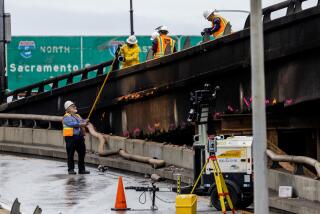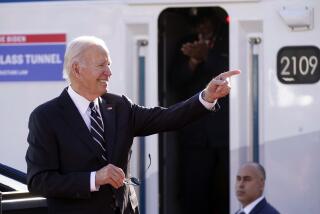50-Year-Old Pennsylvania Turnpike Provided Modern Road to Future : Transportation: The 160-mile route through the Appalachian Mountains was the precursor of the interstate highway system.
- Share via
HARRISBURG, Pa. — The Pennsylvania Turnpike’s goal when it opened 50 years ago was to provide a fast way over and through the Appalachian Mountains. What it gave America was a faster way to the future.
The 160-mile, four-lane ribbon of concrete became the precursor of the United States’ interstate highway system, conquering 2,800-foot hills with slopes, wide lanes, rest areas and exit ramps that became the standard for today’s superhighways. It opened Oct. 1, 1940.
“When the federal government was developing the interstate system, they had us as an example,” said Neal Wood, chief bridge engineer on the highway and the Pennsylvania Turnpike Commission’s unofficial historian.
“When we had a good design, they used it. When one was bad, they changed it,” Wood said.
The turnpike was, and still is, an engineering marvel. The original section snaked its way from Irwin, near Pittsburgh, to Middlesex, near Harrisburg, through seven tunnels and across scores of bridges.
The road’s groundwork, both literally and figuratively, had been laid a half-century earlier by the New York Central Railroad. William Vanderbilt started tunnel work and grading on a “South Penn” route to compete with the Pennsylvania Railroad, which ran through Altoona.
Both railroads were persuaded to ease their competition for fear both would go out of business. “On one telegram’s notice, work was stopped, everyone was paid off, accounts were settled and the line was abandoned,” Wood said.
In the 1930s state lawmakers and lobbyists joked about erecting a truckers’ highway on old bridge pilings across the Susquehanna River. That “joke” has since been recognized by the American Society of Civil Engineers as a National Civil Engineering Landmark.
Highway systems until that time were not systems at all, but roads that meandered from town square to town square. When the original section of the Pennsylvania Turnpike was opened, it bypassed 939 cross streets, 12 railroad crossings and 25 traffic signals along U.S. 11 and U.S. 30, the old Lincoln Highway.
“This became more than a way of getting across Pennsylvania. It was a tourist attraction,” Wood said.
The U.S. Bureau of Public Roads had predicted only 715 cars would travel the turnpike each day in 1940. Other government studies predicted toll roads would never work.
But in the highway’s first four days, 6,000 cars traveled the turnpike each day. On Oct. 6, 1940, the turnpike got its first dose of Sunday drivers, when 27,000 clogged the artery.
“Attendants at three of the interchanges ran out of passenger-car tickets and resorted to handing out light-truck tickets or handwritten notes,” according to a history of the turnpike.
Many communities had shunned turnpike workers during construction, fearing towns would die once the highway opened. But many prospered.
“When they build a bypass around a community, the economic impact is not that great,” said Robert Barnoff, visiting professor of civil engineering at Bucknell University. “What they lose in gasoline or hamburger sales, they usually get back by attracting industry with their better transportation system.”
Even before the original section opened, the turnpike planned expansion to Philadelphia and the Ohio state line. Three more extensions opened by 1957. Currently, the turnpike commission is building two more offshoots: to the Greater Pittsburgh International Airport and around Greensburg. Another new section is planned from Pittsburgh south to Morgantown, W. Va.
With no recent toll-road precedents, early turnpike employees had to improvise. Lee Rishel was asked to train the toll collectors, but did not know how much they were supposed to collect.
“What they did at toll bridges and tunnels was collect at the point of entry and let people cross. There were no toll roads like this, with eight intermediate exits, so we had to come up with a fare schedule,” said Rishel, 78.
Rishel’s committee determined that automobile drivers should pay a penny per mile and that truckers should pay a little more.
How much more was difficult to determine.
“At first we had a mess with the classification,” he said. “We classified by vehicle size, but it was a cause of complaint among truckers because a truck hauling feathers was paying the same as a truck hauling steel.” In 1955, the turnpike began assessing trucks by weight.
In 1956, with the start of the interstate system, the turnpike’s image began to change. The highway went from being an industry standard for excellence to a standard of how highways should not be built.
“There are four lanes of traffic, two in both directions, and a narrow divider,” Barnoff said. “They had a lot of head-on collisions, and at the speeds they were traveling you had some big ones. Lots of fatalities.”
The first speed limit, 70 m.p.h., was not posted until the highway was open 6 1/2 months. Concrete barriers along the median strip were completed in 1969.
The fatality rate on the highway now is among the lowest in the nation among turnpikes, 0.8 per 100 million miles driven. The rate for all rural interstates is 1.6 per 100 million miles, according to turnpike figures.
But cars still shine headlights across the lanes at a distance of 10 feet. And there isn’t much room for improvement.
“The growth that’s occurred across the roadway fence makes it difficult to convert our highway to what people are accustomed to,” Martin said. “Our success has been our limitation. We’ve pinned ourselves in by development.”
More to Read
Sign up for Essential California
The most important California stories and recommendations in your inbox every morning.
You may occasionally receive promotional content from the Los Angeles Times.













